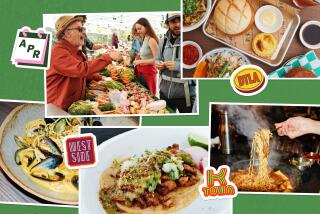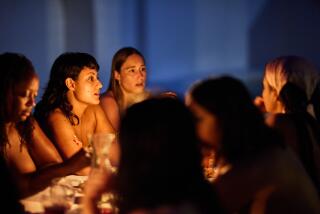Dinner is the theater as food paparazzi converge
The paparazzi target wasn’t hard to find: The star smelled distinctly of fish.
Camera flashes cut across the softly lighted downtown Los Angeles restaurant, as the crowd at Ludo Bites jostles for the coveted photo -- of the Columbian River king salmon confit.
A few minutes later, as a server walked past with a plate of foie gras terrine, 18 food bloggers aimed their cameras and prepared to fire anew.”This is the game we all now play,” chef and owner Ludo Lefebvre said through gritted teeth. “We cook, we smile -- and the people, they don’t eat. They get their cameras.”
Not so long ago, diners, hungry for a memento of special meals, would pull out a point-and-shoot at a restaurant for a quick picture of sliced birthday cake.
No more. Taking a cue from Twitter and Facebook cultures, serious foodies and casual consumers alike are using digital technology to document each bite, then sharing or swapping the pictures online.
Chefs call them the food paparazzi, and these days, no morsel is too minor.
Flickr, the photo-sharing website, has seen the number of pictures tagged as “food” jump from about half a million in 2008 to more than 6 million today, according to company officials. In the group “I Ate This” on Flickr’s site, nearly 20,000 people have uploaded more than 307,000 images of their latest meals, from a 7-Eleven hot dog smeared with mustard to the butter dish at the Michelin three-star restaurant French Laundry in Yountville, Calif.
Camera manufacturers are joining the trend. Nikon, Olympus and Sony sell cameras that offer “cuisine” or “food” settings, which adjust to enhance colors and textures on close-ups.
“I’m sharing my experiences with my friends,” said Hong Pham, 33, a Los Angeles radiologist who runs the food blog Ravenous Couple. “Why shouldn’t I share what inspires me?”
But what is documentary fun for people such as Pham is souring the gastronomic set.
Maitre d’s regularly face diners demanding to be moved away from camera flashes and the sound of firing shutters. Waiters find themselves tongue-tied as customers thrust voice recorders at them to capture a recitation of each course. Some chefs have had enough.
Chef Grant Achatz allows only non-flash photography in his tony Chicago restaurant, Alinea. He, like many chefs, finds himself torn between being flattered by the public’s enthusiasm and aggravated over the effect the picture-taking is having on the restaurant’s operations.
“They’ve paid for the meal, so they think they can do whatever they want with it,” he said.
Some consumers now believe food should be consumed visually as well as physically.
“What happened to the enjoyment of just eating the food?” decried Andrew Knowlton, the restaurant editor for Bon Appetit magazine. “People are losing sight of why you go out.”
The trend has flourished as social media have converged with the rise of the so-called foodie culture, in which chefs have become celebrities and the Food Network has rekindled the public’s appetite for all things edible. Blogger gourmands began reviewing their favorite restaurants and posting snapshots to illustrate their experiences.
“Now, [eating] is the entertainment,” Knowlton said. “It’s like if you were going to a theater or a sporting event, and taking a photograph of your favorite performer or athlete. But now, your favorite star is the plate.”
For Linden Goh, who runs a Los Angeles entertainment production company, the practice appealed to his fascination with how food looks. “I’ve always been a visual person. I’d rather watch the movie than read the book,” said Goh, 39, who shoots what he eats at least once a week and posts the photos on his blog, the Gastronomnom.
Goh first pulled out his cellphone last fall at the grand opening of the Gorbals, a restaurant owned by Ilan Hall, a winner of the Bravo cable TV series “Top Chef.” He said that as he sat down at a long communal table, he glanced around the dining room. He felt self-conscious over what he was about to do.
The server put down the first course: a slab of Manischewitz-braised pork belly. He took a deep breath as he aimed his cellphone. Looking up, he realized other people were too busy taking pictures of their own plates to notice him.
He was hooked. He quickly started shopping for a better camera.
In some ways, the culinary world brought this on itself. As public interest in fine dining has grown, more restaurants have been catering to those appetites in settings far more casual than those of their predecessors. Yet for all that was gained with such expansion, something also was lost: civility.
When Achatz opened his restaurant in 2005, he said he wasn’t surprised when a few customers started showing up with cameras. After all, his style of food is theatrical and unusual: He once interpreted a peanut-butter-and-jelly sandwich as a peeled grape, still on the stem, dipped in peanut puree and wrapped in brioche.
But in the last year, the food paparazzi have taken over. They videotape every course -- as well as the restaurant’s ceiling, menu and table decor. They record clips of Achatz serving table-side and post them on YouTube. One customer recently booked a reservation for two, but requested a table for four to accommodate the tripod for his camera.
Each shot takes time and those delays add up. On average, Achatz said, people who photograph their food spend an extra five minutes per course. “That’s going to slow down our 13-course dinner, at best, an hour,” he said. “I have people waiting in our lobby for their table, and there’s not a thing we can do about it.”
Yet few chefs have banned such photography. A sluggish economy has made them wary of alienating customers. They also know the photos help generate free publicity, as does a positive buzz on social media networks.
Sometimes, chefs reason, it’s better to try to embrace the shutterbugs.
Lefebvre, for one, is grateful. The food paparazzi have let his wife, Krissy, use their pictures for free for marketing purposes. The online buzz helped him quickly sell out every reservation for his latest endeavor -- a restaurant that will be open only for seven weeks.
So this month, on the eve of Ludo Bites’ grand opening, Lefebvre happily cooked a private dinner for 18 food bloggers. His wife set up a portable light box in a corner of the dining room.
Even before the bread plates hit the table, the crowd went nuts. As each new dish arrived, the bloggers rushed over to the light box to get the shot, then returned to their seats.
Lefebvre fought for patience. His forehead wrinkled in frustration as he watched the steam dissipate off bowls of escargot and plates of fish.
Finally, he broke.
“Respect the food! The salmon’s getting cold!” Lefebvre bellowed.
The crowd turned to stare. Six people pointed cameras at the chef. Click.
p.j.huffstutter@latimes.com
More to Read
Eat your way across L.A.
Get our weekly Tasting Notes newsletter for reviews, news and more.
You may occasionally receive promotional content from the Los Angeles Times.






